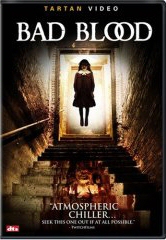
Oral beliefs, rituals, and superstitions evoke a sense of awe and terror in the world around us (and hint at the unfathomable depths within us), arming us with symbols, imagery, and themes as guides to examine aspects of the human condition. Death, possible after-lives, natural forces, and fear of the unknown-- these are just a small hand-full of the topics that folklore deals in. These same issues have been -- and remain -- an integral aspect of fiction and cinema. Truly memorable are those films that use classic horror archetypes as masks by which we can face the terrors of our own time and culture, making the universal more understandable (and approachable) by sharing the intimacy of our own lives. Bad Blood, a menacing melting-pot of various supernatural tropes from Tartan Asia Extreme, filters such cosmic horrors as untimely death, the unknown, and the supernatural through the day-to-day demands and anxieties of a family. While Tartan is most revered for bringing to light obscure nightmares from Asia, this redefined and psychologically mature ghost stems from Portugal and wisely works its native folk beliefs and lore into the main narrative.
An understated ghost story, Bad Blood merges aspects of traditional supernatural fiction with a greater emphasis on the routine trials and tribulations of everyday life, something rarely found in today's heavy handed shock cinema. A noted if self satisfied scholar, Dr. Monteiro, forces his family to relocate to a menacing home in a village isolated from outside influence or comforts. Seeped in the mystery and tradition of oral belief, the house breaths with a haunted, repressed atmosphere that is itself reflective of the surrounding neighbourhood, as well as indicative of the threat coming from within the dwelling . . . and the people who reside there. Inheriting the house from a great uncle, Monterio doesn't listen to his children's suggestion that he sell the new home and stay in the city, further straining an already rocky relationship. When he discovers that he's inherited an ancient curse along with the house, the good doctor grapples through a merciless labyrinth of self knowledge and ghostly vengeance, all circling around his ancestors, who obtained the house by killing a family that refused to sell. Folklore says that the head of that deceased, vengeful family now lurks in the countryside with the spirits of his beloved dead, waiting for the opportunity to revenge himself.
An adult, mature, if sadly disjointed supernatural examination of small town life and politics, the most personal horrors to be found here are in the structure of the family itself. A ghost story whose hinted-at supernatural manifestations are surpassed by the immediate hostility, prejudice, and ignorance of parents and siblings, there is nothing more shocking and emotionally repulsive here than the day to day life of people. Directors Tiago Guedes and Frederico evoke a nightmarish atmosphere immediately, mirroring the terse anxiety of the family in the surrounding countryside, as both are shadowed by the power of folklore and small town isolation. In the midst of all this is the fore-mentioned familial struggle that allows the preternatural to penetrate and obsess already fractured minds. A slow burn whose intent was to mirror the atmospheric intensity of such classics as Turn of the Screw or The Lady in Black, this homage to quiet, suggestive horror film exchanges splatter tactics for mood, tone, and psychological intensity. Characterization is emotionally believable and complex, and helps the atmospheric surroundings to create a context with which to support the occult incidents -- when they finally arrive. Unfortunately the supernatural elements arrive too little too late, lacking the emotional and aesthetic payoff we are led to expect. The supernatural element is neglected, thrown in as an afterthought when it could have been utilized as an extension of character. Thankfully, we DO get a fairly steady undercurrent of unease -- a palpable sense of dread that makes the journey through the lives of Monteiro and his family worth the trouble regardless of a final lack of supernatural cataclysm. Then again, when tragedy does strike, it is potent and painful enough not to require a 'boo!'
Bad Blood is featured in 1.85:1 anamorphic widescreen. While some scenes suffer from speckled picture and grain, for the most part the picture is free from blemish, and the colors solid, skin tones realistic. The Audio track in Dolby Digital 5.1 is in the original Portuguese, and is clear and effective, evenly distributing effects.
Extras for this uneven if tense modern ghost fable consist of the Theatrical Trailer and an in depth "behind the scenes" featurette that includes cast and crew interviews, snippets of the producer and directors, and scenes from the film, all merged to explore the back story in an intriguing, exhaustive manner.
Review by William P Simmons
| Released by Tartan Video |
| Region 1 - NTSC |
| Not Rated |
| Extras : |
| see main review |